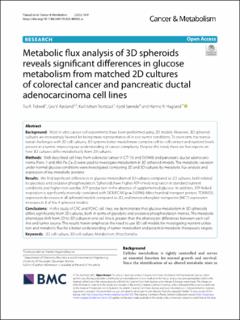| dc.contributor.author | Tidwell, Tia R. | |
| dc.contributor.author | Røsland, Gro Vatne | |
| dc.contributor.author | Tronstad, Karl Johan | |
| dc.contributor.author | Søreide, Kjetil | |
| dc.contributor.author | Hagland, Hanne Røland | |
| dc.date.accessioned | 2022-06-20T11:24:57Z | |
| dc.date.available | 2022-06-20T11:24:57Z | |
| dc.date.created | 2022-06-15T14:32:01Z | |
| dc.date.issued | 2022 | |
| dc.identifier.issn | 2049-3002 | |
| dc.identifier.uri | https://hdl.handle.net/11250/2999588 | |
| dc.description.abstract | Background
Most in vitro cancer cell experiments have been performed using 2D models. However, 3D spheroid cultures are increasingly favored for being more representative of in vivo tumor conditions. To overcome the translational challenges with 2D cell cultures, 3D systems better model more complex cell-to-cell contact and nutrient levels present in a tumor, improving our understanding of cancer complexity. Despite this need, there are few reports on how 3D cultures differ metabolically from 2D cultures.
Methods
Well-described cell lines from colorectal cancer (HCT116 and SW948) and pancreatic ductal adenocarcinoma (Panc-1 and MIA-Pa-Ca-2) were used to investigate metabolism in 3D spheroid models. The metabolic variation under normal glucose conditions were investigated comparing 2D and 3D cultures by metabolic flux analysis and expression of key metabolic proteins.
Results
We find significant differences in glucose metabolism of 3D cultures compared to 2D cultures, both related to glycolysis and oxidative phosphorylation. Spheroids have higher ATP-linked respiration in standard nutrient conditions and higher non-aerobic ATP production in the absence of supplemented glucose. In addition, ATP-linked respiration is significantly inversely correlated with OCR/ECAR (p = 0.0096). Mitochondrial transport protein, TOMM20, expression decreases in all spheroid models compared to 2D, and monocarboxylate transporter (MCT) expression increases in 3 of the 4 spheroid models.
Conclusions
In this study of CRC and PDAC cell lines, we demonstrate that glucose metabolism in 3D spheroids differs significantly from 2D cultures, both in terms of glycolytic and oxidative phosphorylation metrics. The metabolic phenotype shift from 2D to 3D culture in one cell line is greater than the phenotypic differences between each cell line and tumor source. The results herein emphasize the need to use 3D cell models for investigating nutrient utilization and metabolic flux for a better understanding of tumor metabolism and potential metabolic therapeutic targets. | en_US |
| dc.language.iso | eng | en_US |
| dc.publisher | BioMed Central | en_US |
| dc.rights | Navngivelse 4.0 Internasjonal | * |
| dc.rights.uri | http://creativecommons.org/licenses/by/4.0/deed.no | * |
| dc.title | Metabolic flux analysis of 3D spheroids reveals significant differences in glucose metabolism from matched 2D cultures of colorectal cancer and pancreatic ductal adenocarcinoma cell lines | en_US |
| dc.type | Journal article | en_US |
| dc.type | Peer reviewed | en_US |
| dc.description.version | publishedVersion | en_US |
| dc.rights.holder | Copyright 2022 The Author(s) | en_US |
| dc.source.articlenumber | 9 | en_US |
| cristin.ispublished | true | |
| cristin.fulltext | original | |
| cristin.qualitycode | 1 | |
| dc.identifier.doi | 10.1186/s40170-022-00285-w | |
| dc.identifier.cristin | 2032164 | |
| dc.source.journal | Cancer & Metabolism | en_US |
| dc.identifier.citation | Cancer & Metabolism. 2022, 10, 9. | en_US |
| dc.source.volume | 10 | en_US |

